The Health Impact of Household Cooking Fuel Choice on Women: Evidence from China
Abstract
1. Introduction
2. Literature Review and Theoretical Framework
2.1. Environmental and Health Impacts of Solid Fuel Combustions
2.2. Environmental and Health Impacts of Clean Fuel Switching
2.3. Theoretical Framework for Variable Selection
3. Methodology and Data
3.1. Methodology
3.2. Data
4. Results and Discussion
4.1. The Results for Descriptive Statistics
4.2. The Results for Econometric Analysis
4.2.1. The Impact of Fuel Switching on the Women’s Health
4.2.2. The Impact of Household Cooking Fuel Choices on the Health of Women of Different Groups
4.2.3. Policy Implications
5. Conclusions
Funding
Institutional Review Board Statement
Informed Consent Statement
Data Availability Statement
Conflicts of Interest
Appendix A
| Variables | Questions |
|---|---|
| IADL | Can you perform outdoor activities independently, such as walking about 300 m to the station, shopping center, or parking lot? |
| Can you eat independently, such as making a cup of tea, breaking off steamed buns, or picking dishes? | |
| Can you perform independent kitchen activities such as preparing lunch for 1–2 people, setting the table, wiping the table after meals, and washing dishes? | |
| Can you use public transport independently, such as taking trams, buses, trains, and boats in your residential area, including going to and from the station, getting on and off the bus, moving within the bus, buying tickets, and finding seats? | |
| Can you shop independently, such as at local stores and shopping centers, including shopping-related activities such as getting in and out of the mall, choosing goods, paying for items, and taking them home? | |
| Can you clean independently, such as making the bed, daily cleaning, mopping the bathroom floor, vacuuming, changing sheets, cleaning windows, and taking out the garbage? | |
| Can you perform laundry independently, including washing sheets and clothes in the laundry room or using your laundry equipment, sorting clothes, choosing laundry procedures, operating the washing machine, putting and taking out clothes, drying clothes, folding and organizing dry laundry? |
References
- IEA. World Energy Outlook 2019; International Energy Agency: Paris, France, 2019; Available online: https://www.iea.org/events/world-energy-outlook-2019 (accessed on 12 September 2021).
- Garba, I.; Bellingham, R. Energy poverty: Estimating the impact of solid cooking fuels on GDP per capita in developing countries-Case of sub-Saharan Africa. Energy 2021, 221, 119770. [Google Scholar] [CrossRef]
- Huang, W.; Baumgartner, J.; Zhang, Y.; Wang, Y.; Schauer, J.J. Source apportionment of air pollution exposures of rural Chinese women cooking with biomass fuels. Atmos. Environ. 2015, 104, 79–87. [Google Scholar] [CrossRef]
- Barron, M.; Torero, M. Household electrification and indoor air pollution. J. Environ. Econ. Manage. 2017, 86, 81–92. [Google Scholar] [CrossRef]
- Jagger, P.; Shively, G. Land use change, fuel use and respiratory health in Uganda. Energy Policy 2014, 67, 713–726. [Google Scholar] [CrossRef]
- Yu, K.; Qiu, G.; Chan, K.H.; Lam, K.B.H.; Kurmi, O.P.; Bennett, D.A.; Yu, C.; Pan, A.; Lv, J.; Guo, Y.; et al. Association of solid fuel use with risk of cardiovascular and all-cause mortality in rural China. JAMA-J. Am. Med. Assoc. 2018, 319, 1351–1361. [Google Scholar] [CrossRef]
- Lee, K.K.; Bing, R.; Kiang, J.; Bashir, S.; Spath, N.; Stelzle, D.; Mortimer, K.; Bularga, A.; Doudesis, D.; Joshi, S.S.; et al. Adverse health effects associated with household air pollution: A systematic review, meta-analysis, and burden estimation study. Lancet Glob. Health 2020, 8, 1427–1434. [Google Scholar] [CrossRef]
- Balmes, J.R. Household air pollution from domestic combustion of solid fuels and health. J. Allergy Clin. Immunol. 2019, 143, 1979–1987. [Google Scholar] [CrossRef] [PubMed]
- Imelda. Indoor air pollution and infant mortality: A new approach. AEA Pap. Proc. 2018, 108, 416–421. [Google Scholar] [CrossRef]
- IEA. World Energy Outlook 2020; International Energy Agency: Paris, France, 2021; Available online: https://www.iea.org/reports/world-energy-outlook-2020 (accessed on 12 September 2021).
- UN. Five Reasons You Should Care About Air Pollution. UN Environ. Programme 2019. Available online: https://www.unep.org/news-and-stories/story/five-reasons-you-should-care-about-air-pollution (accessed on 12 September 2021).
- Yasmin, N.; Grundmann, P. Home-cooked energy transitions: Women empowerment and biogas-based cooking technology in Pakistan. Energy Policy 2020, 137, 111074. [Google Scholar] [CrossRef]
- WHO. Household Air Pollution and Health; World Health Organization, 2018; Available online: https://www.who.int/news-room/fact-sheets/detail/household-air-pollution-and-health (accessed on 12 September 2021).
- WHO. WHO Guidelines for Indoor Air Quality: Household Fuel Combustion; World Health Organization, 2014; Available online: http://europepmc.org/article/med/25577935 (accessed on 12 September 2021).
- Rahut, D.B.; Ali, A.; Mottaleb, K.A. Understanding the determinants of alternate energy options for cooking in the Himalayas: Empirical evidence from the Himalayan region of Pakistan. J. Clean. Prod. 2017, 149, 528–539. [Google Scholar] [CrossRef]
- Johnson, O.W.; Gerber, V.; Muhoza, C. Gender, culture and energy transitions in rural Africa. Energy Res. Soc. Sci. 2019, 49, 169–179. [Google Scholar] [CrossRef]
- Oluwole, O.; Otaniyi, O.O.; Ana, G.A.; Olopade, C.O. Indoor air pollution from biomass fuels: A major health hazard in developing countries. J. Public Health 2012, 20, 565–575. [Google Scholar] [CrossRef]
- Yasmin, N.; Grundmann, P. Adoption and diffusion of renewable energy-The case of biogas as alternative fuel for cooking in Pakistan. Renew. Sustain. Energy Rev. 2019, 101, 255–264. [Google Scholar] [CrossRef]
- Choudhuri, P.; Desai, S. Gender inequalities and household fuel choice in India. J. Clean. Prod. 2020, 265, 121487. [Google Scholar] [CrossRef] [PubMed]
- National Bureau of Statistics. Communiqué on major data of the third national agricultural census (No. 4). Natl. Bur. Statistics 2017. Available online: http://www.stats.gov.cn/tjsj/tjgb/nypcgb/qgnypcgb/201712/t20171215_1563634.html (accessed on 12 September 2021).
- Zhang, J.D.; Liu, W.J.; Xu, Y.S.; Cai, C.Y.; Liu, Y.; Tao, S.; Liu, W.X. Distribution characteristics of and personal exposure with polycyclic aromatic hydrocarbons and particulate matter in indoor and outdoor air of rural households in Northern China. Environ. Pollut. 2019, 255, 113176. [Google Scholar] [CrossRef]
- Yun, X.; Shen, G.; Shen, H.; Meng, W.; Chen, Y.; Xu, H.; Ren, Y.; Zhong, Q.; Du, W.; Ma, J.; et al. Residential solid fuel emissions contribute significantly to air pollution and associated health impacts in China. Sci. Adv. 2020, 6, eaba7621. [Google Scholar] [CrossRef] [PubMed]
- Fang, L.M.; Lu, N. Can the middle-aged and the elderly achieve their health improvement from domestic energy consumption structure optimization in rural China. China Popul. Resour. Environ. 2019, 29, 40–49. [Google Scholar]
- Liu, Z.; Li, J.; Rommel, J.; Feng, S. Health impacts of cooking fuel choice in rural China. Energy Econ. 2020, 89, 104811. [Google Scholar] [CrossRef] [PubMed]
- Song, D.Y.; Li, D.F. The improvement of rural household fuel structure and residents’ health returns in China-Test based on CFPS data. J. Henan Univ. 2021, 61, 57–63. [Google Scholar]
- Nie, P.; Sousa-Poza, A.; Xue, J. Fuel for life: Domestic cooking fuels and women’s health in rural China. Int. J. Environ. Res. Public Health 2016, 13, 810. [Google Scholar] [CrossRef] [PubMed]
- Gajate-Garrido, G. The impact of indoor air pollution on the incidence of life threatening respiratory illnesses: Evidence from young children in Peru. J. Dev. Stud. 2013, 49, 500–515. [Google Scholar] [CrossRef]
- Fillenbaum, G.G. Screening the elderly: A brief instrumental activities of daily living measure. J. Am. Geriatr. Soc. 1985, 33, 698–706. [Google Scholar] [CrossRef] [PubMed]
- Franks, P.; Gold, M.R.; Fiscella, K. Sociodemographics, self-rated health, and mortality in the US. Soc. Sci. Med. 2003, 56, 2505–2514. [Google Scholar] [CrossRef]
- Tian, Z.; Tian, Y.; Shen, L.; Shao, S. The health effect of household cooking fuel choice in China: An urban-rural gap perspective. Technol. Forecast. Soc. Chang. 2021, 173, 121083. [Google Scholar] [CrossRef]
- Demirbaş, A. Biomass resource facilities and biomass conversion processing for fuels and chemicals. Energy Convers. Manag. 2001, 42, 1357–1378. [Google Scholar] [CrossRef]
- Hendryx, M.; Zullig, K.J.; Luo, J. Impacts of coal use on health. Annu. Rev. Public Health 2020, 41, 397–415. [Google Scholar] [CrossRef]
- Ali, M.U.; Yu, Y.; Yousaf, B.; Munir, M.A.M.; Ullah, S.; Zheng, C.; Kuang, X.; Wong, M.H. Health impacts of indoor air pollution from household solid fuel on children and women. J. Hazard. Mater. 2021, 416, 126127. [Google Scholar] [CrossRef]
- Clark, M.L.; Peel, J.L.; Balakrishnan, K.; Breysse, P.N.; Chillrud, S.N.; Naeher, L.P.; Rodes, C.E.; Vette, A.F.; Balbus, J.M. Health and household air pollution from solid fuel use: The need for improved exposure assessment. Environ. Health Perspect. 2013, 121, 1120–1128. [Google Scholar] [CrossRef] [PubMed]
- Afaj, A. IARC Monograph on the evaluation of carcinogenic risk to humans, volume 95: Household use of solid fuels and high-temperature frying. Int. J. Environ. Stud. 2011, 68, 252–253. [Google Scholar] [CrossRef]
- Ni, K.; Carter, E.; Schauer, J.J.; Ezzati, M.; Zhang, Y.; Niu, H.; Lai, A.M.; Shan, M.; Wang, Y.; Yang, X.; et al. Seasonal variation in outdoor, indoor, and personal air pollution exposures of women using wood stoves in the Tibetan Plateau: Baseline assessment for an energy intervention study. Environ. Int. 2016, 94, 449–457. [Google Scholar] [CrossRef] [PubMed]
- Chen, Y.; Shen, G.; Liu, W.; Du, W.; Su, S.; Duan, Y.; Lin, N.; Zhuo, S.; Wang, X.; Xing, B.; et al. Field measurement and estimate of gaseous and particle pollutant emissions from cooking and space heating processes in rural households, northern China. Atmos. Environ. 2016, 125, 265–271. [Google Scholar] [CrossRef]
- Peng, L.; Zhang, Q.; Yao, Z.; Mauzerall, D.L.; Kang, S.; Du, Z.; Zheng, Y.; Xue, T.; He, K. Underreported coal in statistics: A survey-based solid fuel consumption and emission inventory for the rural residential sector in China. Appl. Energy 2019, 235, 1169–1182. [Google Scholar] [CrossRef]
- Zhou, Y.; Zi, T.; Lang, J.; Huang, D.; Wei, P.; Chen, D.; Cheng, S. Impact of rural residential coal combustion on air pollution in Shandong, China. Chemosphere 2020, 260, 127517. [Google Scholar] [CrossRef]
- Gu, Y.; Zhang, W.; Yang, Y.; Wang, C.; Streets, D.G.; Yim, S.H.L. Assessing outdoor air quality and public health impact attributable to residential black carbon emissions in rural China. Resour. Conserv. Recycl. 2020, 159, 104812. [Google Scholar] [CrossRef]
- Du, W.; Li, X.; Chen, Y.; Shen, G. Household air pollution and personal exposure to air pollutants in rural China–A review. Environ. Pollut. 2018, 237, 625–638. [Google Scholar] [CrossRef]
- Smith, K.R.; Uma, R.; Kishore, V.V.N.; Zhang, J.; Joshi, V.; Khalil, M.A.K. Greenhouse implications of household stoves: An analysis for India. Annu. Rev. Energy Environ. 2000, 25, 741–763. [Google Scholar] [CrossRef]
- Zhang, J.; Smith, K.R.; Ma, Y.; Ye, S.; Jiang, F.; Qi, W.; Liu, P.; Khalil, M.A.K.; Rasmussen, R.A.; Thorneloe, S.A. Greenhouse gases and other airborne pollutants from household stoves in China: A database for emission factors. Atmos. Environ. 2000, 34, 4537–4549. [Google Scholar] [CrossRef]
- Díaz, E.; Smith-Sivertsen, T.; Pope, D.; Lie, R.T.; Díaz, A.; McCracken, J.; Bakke, P.; Arana, B.; Smith, K.R.; Bruce, N. Effect of reducing indoor air pollution on women’s respiratory symptoms and lung function: The RESPIRE Randomized Trial, Guatemala. Am. J. Epidemiol. 2009, 170, 211–220. [Google Scholar] [CrossRef]
- Zhang, W.; Li, A.; Xu, Y.; Liu, J. The theory-practice gap of black carbon mitigation technologies in rural China. Atmos. Environ. 2018, 174, 122–131. [Google Scholar] [CrossRef]
- Pokhrel, A.K.; Smith, K.R.; Khalakdina, A.; Deuja, A.; Bates, M.N. Case-control study of indoor cooking smoke exposure and cataract in Nepal and India. Int. J. Epidemiol. 2005, 34, 702–708. [Google Scholar] [CrossRef]
- Zhang, J.; Smith, K.R. Household air pollution from coal and biomass fuels in China: Measurements, health impacts, and interventions. Environ. Health Perspect. 2007, 115, 848–855. [Google Scholar] [CrossRef]
- Sapkota, A.; Gajalakshmi, V.; Jetly, D.H.; Roychowdhury, S.; Dikshit, R.P.; Brennan, P.; Hashibe, M.; Boffetta, P. Indoor air pollution from solid fuels and risk of hypopharyngeal/laryngeal and lung cancers: A multicentric case-Control study from India. Int. J. Epidemiol. 2008, 37, 321–328. [Google Scholar] [CrossRef][Green Version]
- Baumgartner, J.; Schauer, J.J.; Ezzati, M.; Lu, L.; Cheng, C.; Patz, J.A.; Bautista, L.E. Indoor air pollution and blood pressure in adult women living in rural China. Environ. Health Perspect. 2011, 119, 1390–1395. [Google Scholar] [CrossRef] [PubMed]
- Epstein, M.B.; Bates, M.N.; Arora, N.K.; Balakrishnan, K.; Jack, D.W.; Smith, K.R. Household fuels, low birth weight, and neonatal death in India: The separate impacts of biomass, kerosene, and coal. Int. J. Hyg. Environ. Health 2013, 216, 523–532. [Google Scholar] [CrossRef] [PubMed]
- Pang, J.; Wu, J.; Ma, Z.; Liang, L.N.; Zhang, T.T. Air pollution abatement effects of replacing coal with natural gas for central heating in cities of China. China Environ. Sci. 2015, 35, 80–92. [Google Scholar]
- Tang, Y.; Liang, R.B. Does energy substitution improve air quality: Analysis from energy pricing mechanism. China Popul. Resour. Environ. 2018, 28, 80–92. (In Chinese) [Google Scholar]
- Zhang, Y.; Li, W.; Wu, F. Does energy transition improve air quality? Evidence derived from China’s Winter Clean Heating Pilot (WCHP) project. Energy 2020, 206, 118130. [Google Scholar] [CrossRef]
- Ellegård, A. Cooking fuel smoke and respiratory symptoms among women in low-income areas in Maputo. Environ. Health Perspect. 1996, 104, 980–985. [Google Scholar] [CrossRef] [PubMed][Green Version]
- Balakrishnan, K.; Parikh, J.; Sankar, S.; Padmavathi, R.; Srividya, K.; Venugopal, V.; Prasad, S.; Pandey, V.L. Daily average exposures to respirable particulate matter from combustion of biomass fuels in rural households of Southern India. Environ. Health Perspect. 2002, 110, 1069–1075. [Google Scholar] [CrossRef]
- Wang, Y.; Chen, X.; Ren, S. Clean energy adoption and maternal health: Evidence from China. Energy Econ. 2019, 84, 104517. [Google Scholar] [CrossRef]
- Cesur, R.; Tekin, E.; Ulker, A. Can natural gas save lives? Evidence from the deployment of a fuel delivery system in a developing country. J. Health Econ. 2018, 59, 420–427. [Google Scholar] [CrossRef] [PubMed]
- Kim, C.; Seow, W.J.; Shu, X.O.; Bassig, B.A.; Rothman, N.; Chen, B.E.; Xiang, Y.B.; Hosgood, H.D.; Ji, B.T.; Hu, W.; et al. Cooking coal use and all-cause and cause-specific mortality in a prospective cohort study of women in Shanghai, China. Environ. Health Perspect. 2016, 124, 1384–1389. [Google Scholar] [CrossRef]
- Fang, L.M.; Liu, H.B. Solid fuels utilization, health equity and energy poverty alleviation in rural China. J. Agrotech. Econ. 2019, 7, 115–125. (In Chinese) [Google Scholar]
- Liao, H.; Tang, X.; Wei, Y.M. Solid fuel use in rural China and its health effects. Renew. Sustain. Energy Rev. 2016, 60, 900–908. [Google Scholar] [CrossRef]
- Liu, J.; Hou, B.; Ma, X.W.; Liao, H. Solid fuel use for cooking and its health effects on the elderly in rural China. Environ. Sci. Pollut. Res. 2018, 25, 3669–3680. [Google Scholar] [CrossRef] [PubMed]
- Greenstone, M.; Jack, B.K. Envirodevonomics: A research agenda for an emerging field. J. Econ. Lit. 2015, 53, 5–42. [Google Scholar] [CrossRef]
- Li, Q.; Jiang, J.; Wang, S.; Rumchev, K.; Mead-Hunter, R.; Morawska, L.; Hao, J. Impacts of household coal and biomass combustion on indoor and ambient air quality in China: Current status and implication. Sci. Total Environ. 2017, 576, 347–361. [Google Scholar] [CrossRef]
- Ning, M.; Gong, J.; Zheng, X.; Zhuang, J. Does new rural pension scheme decrease elderly labor supply? Evidence from CHARLS. China Econ. Rev. 2016, 41, 315–330. [Google Scholar] [CrossRef]
- Arku, R.E.; Brauer, M.; Duong, M.L.; Wei, L.; Hu, B.; Ah Tse, L.; Mony, P.K.; Lakshmi, P.V.M.; Pillai, R.K.; Mohan, V.; et al. Adverse health impacts of cooking with kerosene: A multi-country analysis within the prospective urban and rural epidemiology study. Environ. Res. 2020, 188, 109851. [Google Scholar] [CrossRef] [PubMed]
- Chattopadhyay, M.; Arimura, T.H.; Katayama, H.; Sakudo, M.; Yokoo, H.F. Subjective probabilistic expectations, household air pollution, and health: Evidence from cooking fuel use patterns in West Bengal, India. Resour. Energy Econ. 2021, 66, 101262. [Google Scholar] [CrossRef]
- Saenz, J.L.; Adar, S.D.; Zhang, Y.S.; Wilkens, J.; Chattopadhyay, A.; Lee, J.; Wong, R. Household use of polluting cooking fuels and late-life cognitive function: A harmonized analysis of India, Mexico, and China. Environ. Int. 2021, 156, 106722. [Google Scholar] [CrossRef]
- Han, H.; Wu, S.; Zhang, Z. Factors underlying rural household energy transition: A case study of China. Energy Policy 2018, 114, 234–244. [Google Scholar] [CrossRef]
- Dilmaghani, M. The causal effects of education on health over the life course: Evidence from Canada. Public Health 2020, 186, 170–177. [Google Scholar] [CrossRef] [PubMed]
- Alem, Y.; Beyene, A.D.; Köhlin, G.; Mekonnen, A. Modeling household cooking fuel choice: A panel multinomial logit approach. Energy Econ. 2016, 59, 129–137. [Google Scholar] [CrossRef]
- Chan, K.W.; Buckingham, W. Is China abolishing the hukou system? China Q. 2008, 195, 582–606. [Google Scholar] [CrossRef]
- Pan, J.; Lei, X.Y.; Liu, G.E. Does health insurance lead to better health? Econ. Res. J. 2013, 4, 140–142. (In Chinese) [Google Scholar]
- Bandyopadhyay, S.; Shyamsundar, P.; Baccini, A. Forests, biomass use and poverty in Malawi. Ecol. Econ. 2011, 70, 2461–2471. [Google Scholar] [CrossRef]
- Hsiao, C. Analysis of Panel Data; Cambridge University Press: Cambridge, UK, 2003. [Google Scholar]
- CFPS. CFPS Public Data. China Family Panel Studies. Available online: http://www.isss.pku.edu.cn/cfps/en/data/public/index.htm (accessed on 12 September 2021).
- Chen, Q. Advanced Econometrics and Stata Applications; Higher Education Press: Beijing, China, 2014. (In Chinese) [Google Scholar]
- Luo, R.R.; Dai, H.X.; Zhang, Y.H.; Qiao, L.P.; Ma, Y.G.; Zhou, M.; Xia, B.; Zhu, Q.Y.; Zhao, Y.Y.; Huang, C. Exposure levels, sources, and health risks of heavy metal components of PM2.5 in housewives in rural Shanghai. Environ. Sci. 2019, 40, 5224–5233. (In Chinese) [Google Scholar]
- Zhai, S.G. Collaborative governance of health poverty: Logic, experience, and path. Gov. Stud. 2018, 34, 53–60. (In Chinese) [Google Scholar]
- Li, Y.; Li, M.Q. A study on health poverty vulnerability and its influencing factors of rural females in China. J. Hubei Minzu Univ. 2021, 39, 105–118. (In Chinese) [Google Scholar]
- Malakar, Y.; Greig, C.; van de Fliert, E. Resistance in rejecting solid fuels: Beyond availability and adoption in the structural dominations of cooking practices in rural India. Energy Res. Soc. Sci. 2018, 46, 225–235. [Google Scholar] [CrossRef]
- Tao, S.; Ru, M.Y.; Du, W.; Zhong, Q.R.; Li, B.G.; Shen, G.F.; Pan, X.L.; Meng, W.J.; Chen, Y.L.; She, H.Z.; et al. Quantifying the rural residential energy transition in China from 1992 to 2012 through a representative national survey. Nat. Energy 2018, 3, 567–573. [Google Scholar] [CrossRef]
- Wu, S.M.; Zheng, X.Y.; You, C.Y.; Wei, C. Household energy consumption in rural China: Historical development, present pattern and policy implication. J. Clean. Prod. 2019, 221, 981–991. [Google Scholar] [CrossRef]
- Han, H.; Wu, S. Rural residential energy transition and energy consumption intensity in China. Energy Econ. 2018, 74, 523–534. [Google Scholar] [CrossRef]
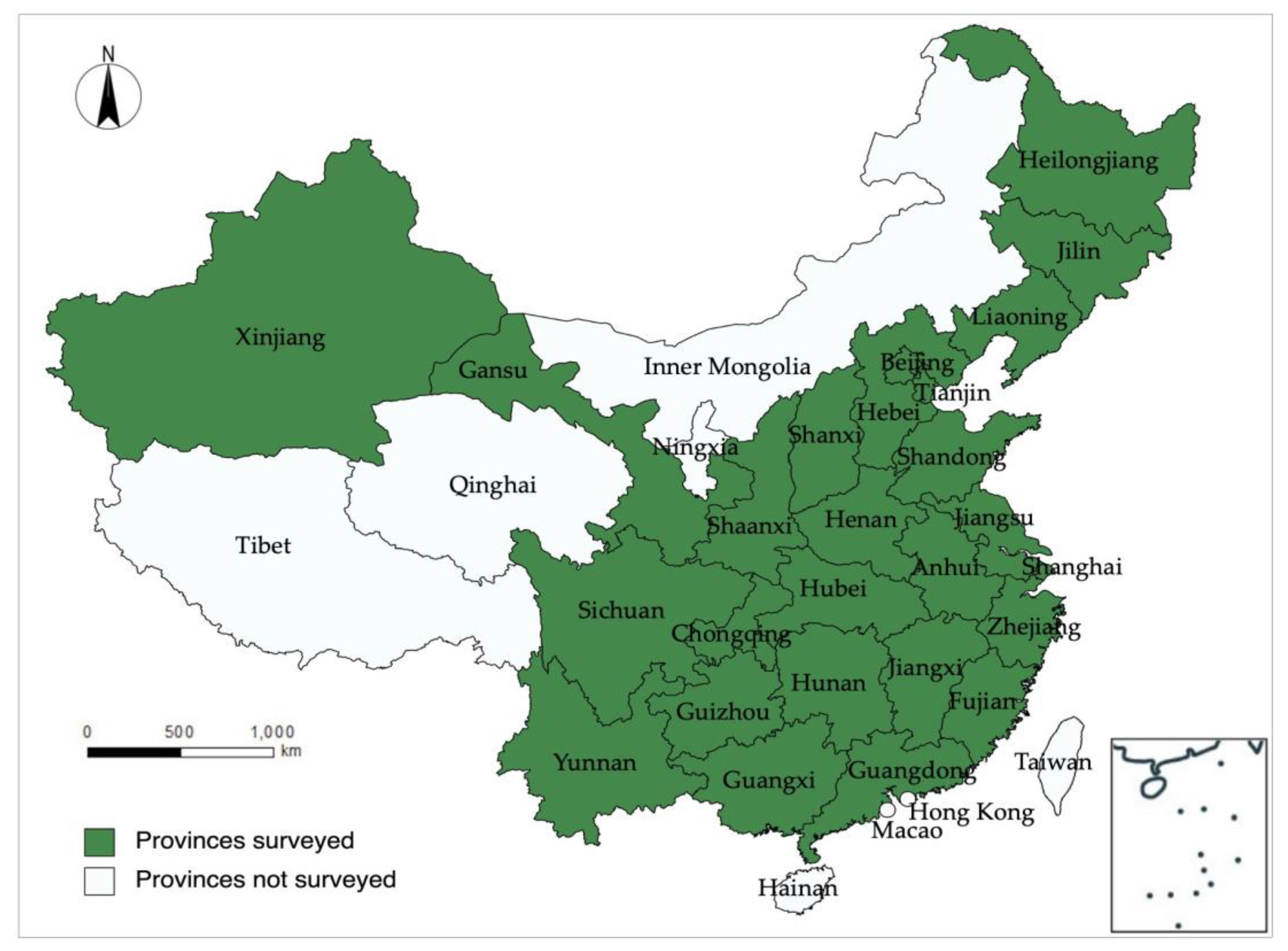
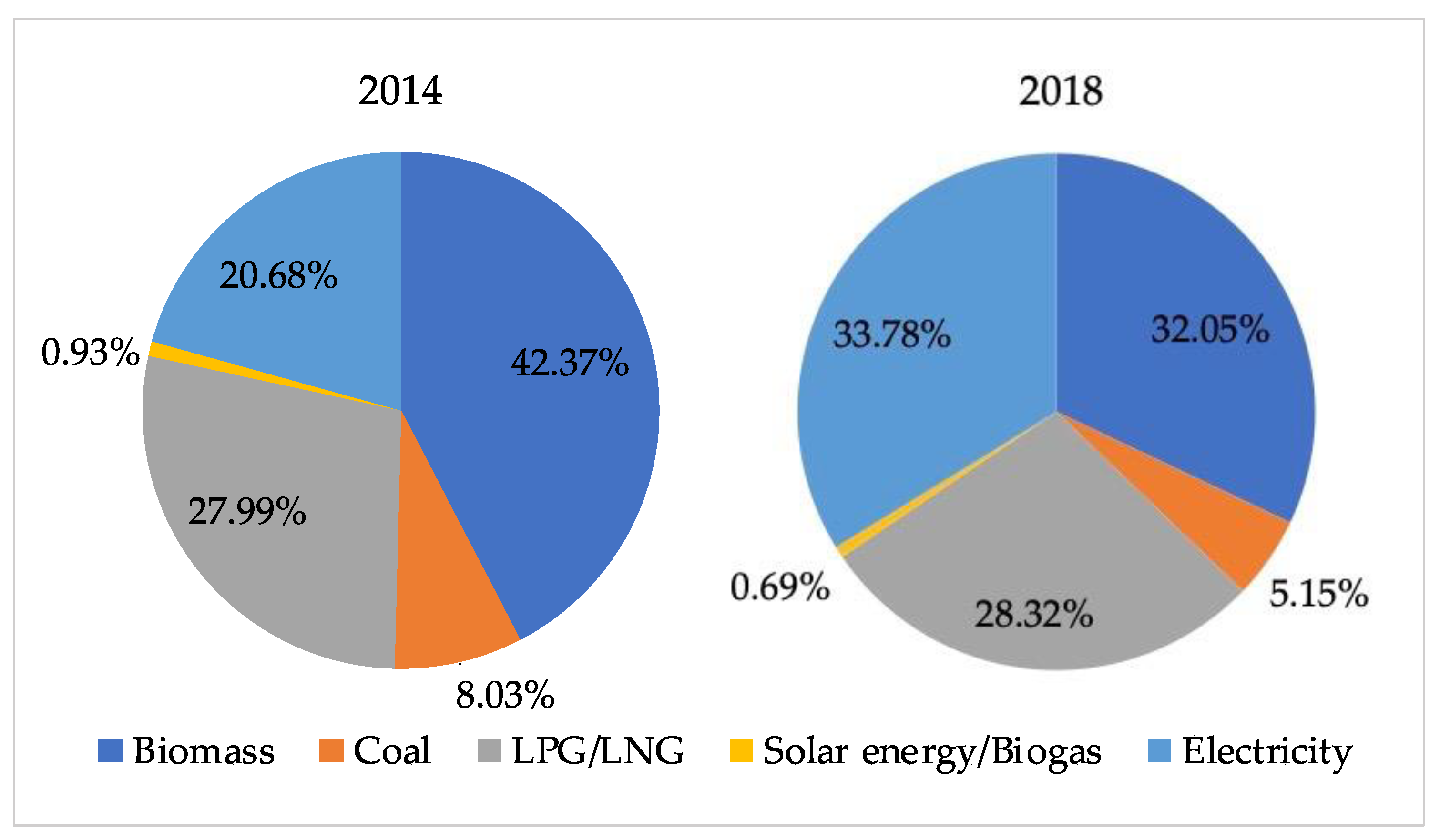
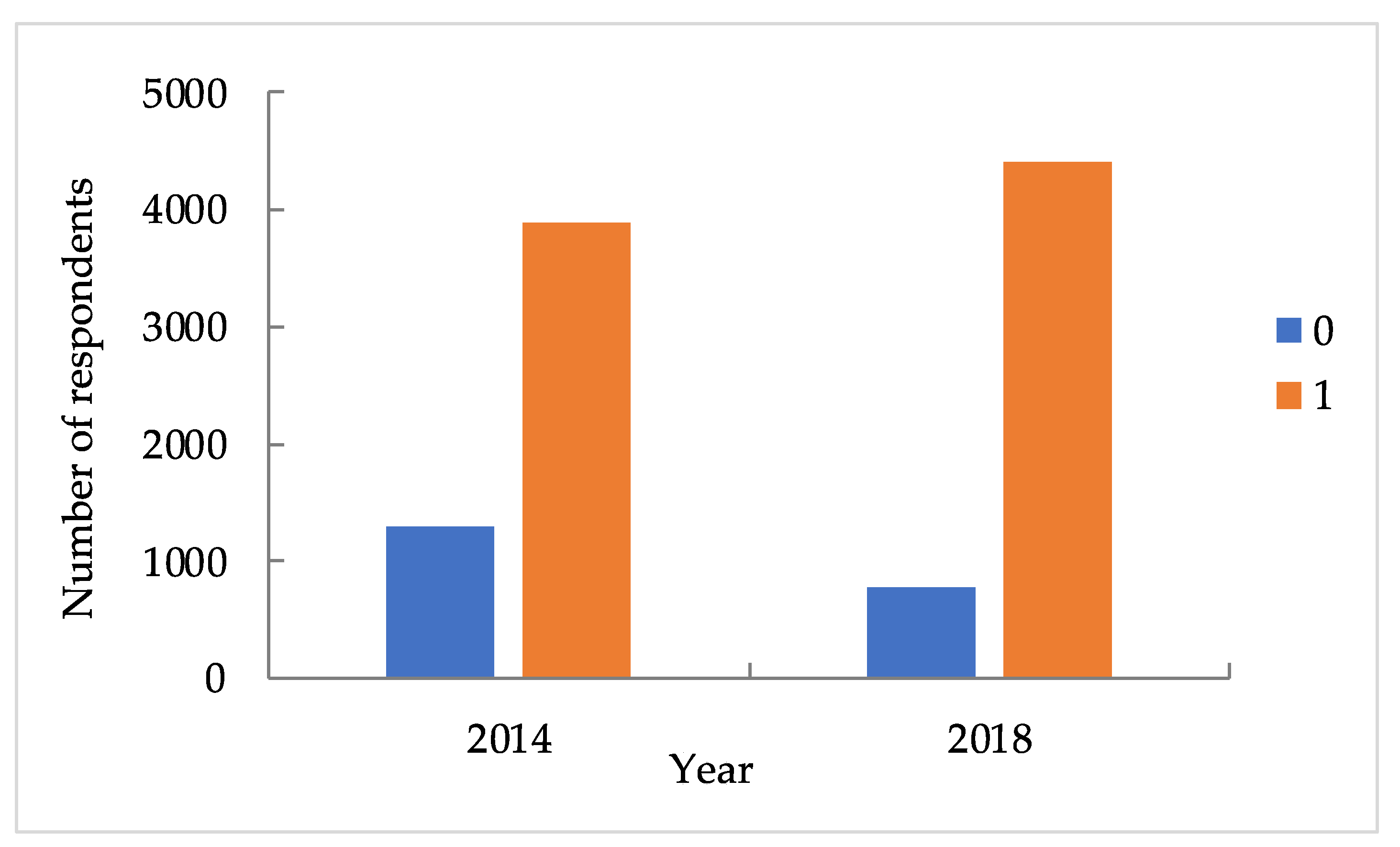
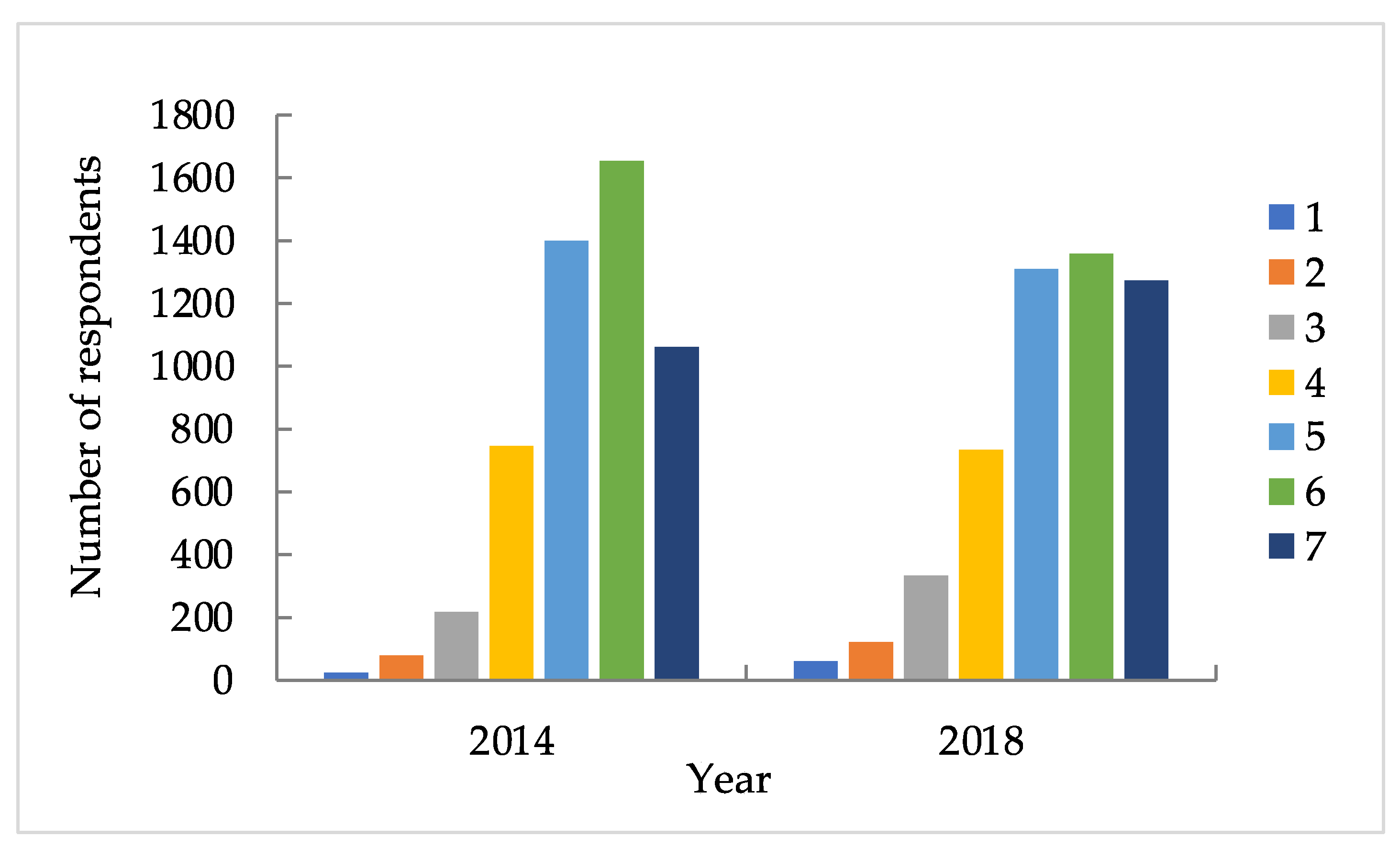
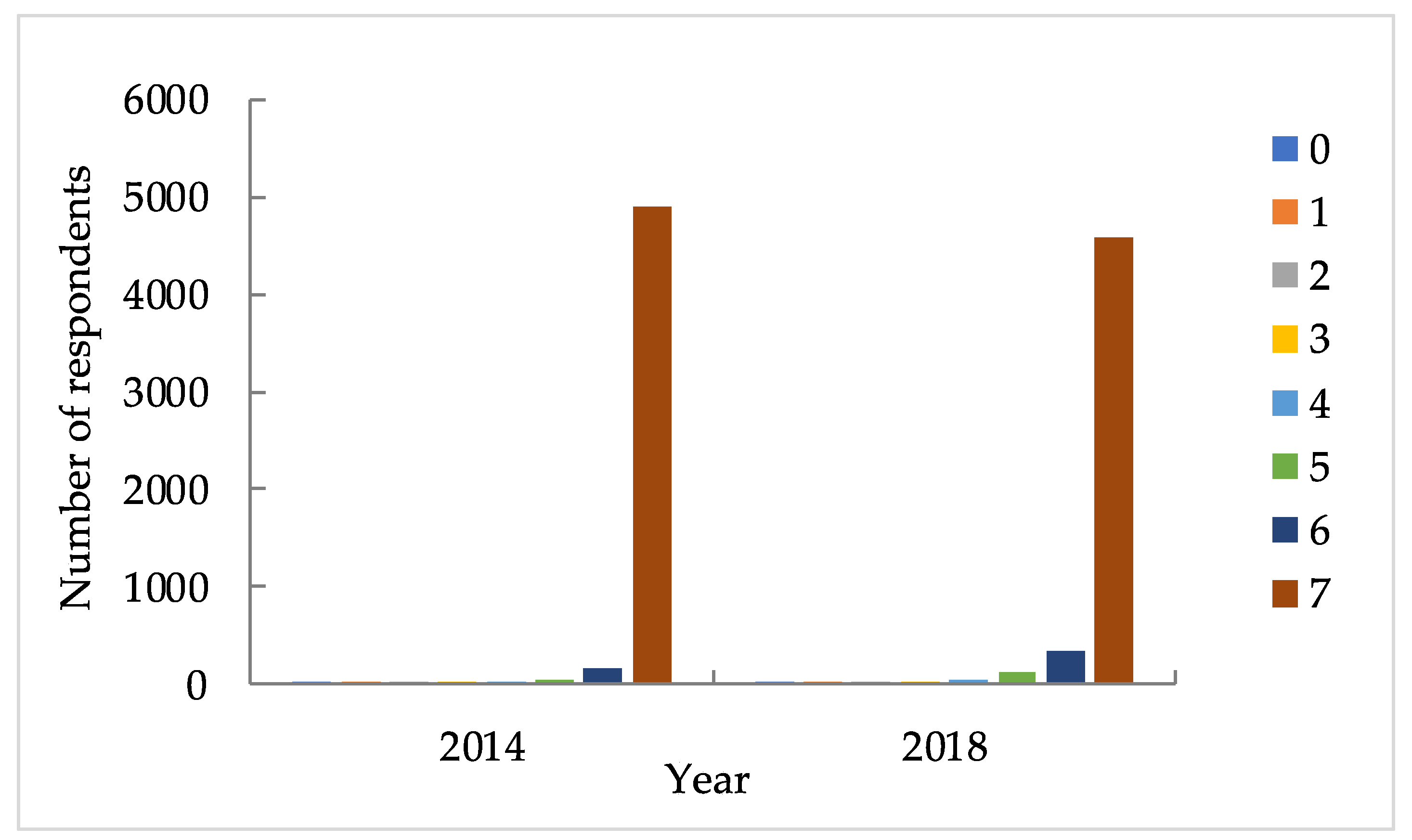
| Solid Fuel | Air Pollutants | Toxicity Mechanisms | Health Impacts |
|---|---|---|---|
| Biomass and Coal | PM2.5, PM10 | Systemic oxidative stress and inflammation | Asthma, lung cancer, chronic obstructive pulmonary disease, cough, aggravation of pre-existing symptoms |
| PHAs | Carcinogenic | Lung cancer, mouth cancer, naso-pharynx and larynx cancer | |
| CO | Carboxy-hemoglobin production, reduced oxygen delivery | Chronic obstructive pulmonary disease exacerbation, low birth weight, perinatal death | |
| NO2 | Increased bronchial reactivity and susceptibility to lung infection | Chronic obstructive pulmonary disease exacerbation, low birth weight, perinatal death | |
| SO2 | Increased bronchial reactivity | Wheezing, asthma exacerbation, cardiovascular disease | |
| Smoke condensate | Adsorption into lens and oxidative change | Cataract, impaired vision, conjunctiva disorders |
| Authors | Health Indicators | Control Variables |
|---|---|---|
| Jagger and Shively [5] | Acute respiratory infection | Fuel choice, household size, age of head, female headed household, education of head, ventilation, improved stove |
| Nie et al. [26] | Chronic/acute disease, fever, asthma, eye disease, heart disease/chest pain, self-reported health | Cooking fuels, education levels, age, working status, household size, water, flushing toilet, no excreta around the dwelling place, electricity, location of health facility, distance to the health facility |
| Liu et al. [61] | Chronic lung diseases, heart problems, stroke, self-assessment of health status, comparison of health status | Solid fuel, income, age, gender, smoke, drink, sleeping time, kitchen, tap water, topography |
| Cesur et al. [57] | Mortality rate | Natural gas, hospital density, hospital bed density, physician density, family medicine program, unemployment rate, per capita GDP, vehicle density, percent high school, percent college, students per teacher, governing party mayor |
| Imelda [9] | Infant mortality | Cooking fuel, mother’s age, first birth, child born in the last five years, antenatal visits, number of household member, television, fridge, cleaning water, health facility, smoking, toilet, electricity, parents’ education |
| Fang and Lu [23] | Self-rated health, Katz index, and IADL | Fuel switching, house type, expenditure, education, Insurance, basic living allowance, smoke, marriage, gender, age, number of household member, number of children, province |
| Wang et al. [56] | Maternal mortality rate | Natural gas density, hospital beds, medical staff, population with maternity insurance, GDP per capita, population size, government revenues per capita, population with high school degree, college students, motor vehicles, temperature, precipitation |
| Arku et al. [65] | Cardiorespiratory symptoms, blood pressure and hypertension, lung function, and air flow obstruction | Cooking fuel choice, education, wealth index, occupation, food expenditure, gender, rural/urban, country |
| Liu et al. [24] | ADL, IADL | Cooking fuel, age, gender, education, marriage, farm work, smoking, drinking, number of children, gender structure, household size, house structure, assets |
| Chattopadhyay et al. [66] | Sick in last 30 days with at least one physical symptom; subjective probabilistic expectations variables | Number of cooks, age, schooling year, marriage, spouse’s work, kitchen located inside dwelling unit, ventilation in cooking area, expenditure, access to internet, television, opportunity to collect cooking fuels for free |
| Saenz et al. [67] | Cognitive function | Age, gender, education, marital status, household wealth, per capita consumption, region, housing status |
| Tian et al. [30] | Self-rated health, chronic diseases | Solid fuels, hukou, location, age, education, gender, jobs, smoke, income, GDP per capita, population density, urbanization |
| Variable | Definition | Mean | Std. | Min. | Max. |
|---|---|---|---|---|---|
| Self-rated | Respondents’ self-rated health status (1 = Health; 0 = Poor health) | 0.80 | 0.40 | 0 | 1 |
| Others-rated | Investigators’ evaluation of respondents’ health status (1–7) | 5.40 | 1.30 | 1 | 7 |
| IADL | Investigators’ instrumental activities of daily living (0–7) | 6.83 | 0.72 | 0 | 7 |
| Fuel | Fuel switching (1 = Biomass; 2 = Coal; 3 = LPG/LNG; 4 = Solar energy/Biogas; 5 = Electricity) | 2.74 | 1.61 | 1 | 5 |
| Income | Annual income of a household (ogarithmic) | 11.18 | 12.03 | 0 | 15.53 |
| Age | Age of the respondent | 49.87 | 14.50 | 16 | 92 |
| Marriage | Whether married or not (1 = Yes; 0 = No) | 0.87 | 0.34 | 0 | 1 |
| Hukou | China’s household registration system (1 = Urban; 0 = Rural) | 0.27 | 0.45 | 0 | 1 |
| Education | Education years (0 = Illiterate/Semiliterate; 6 = Elementary school; 9 = Junior high school; 12 = Senior high school/Technical school/Technical school/Vocational high school; 15 = Junior college; 16 = Undergraduate; 18 = Graduate) | 5.82 | 5.11 | 0 | 18 |
| Insurance | (1 = Having insurance; 0 = No insurance) | 0.93 | 0.25 | 0 | 1 |
| Smoke | (1 = Smoking; 0 = No smoking) | 0.03 | 0.18 | 0 | 1 |
| Member | The number of family members | 4.27 | 1.97 | 1 | 21 |
| POLS | FE | |||||
|---|---|---|---|---|---|---|
| (1) | (2) | (3) | (4) | (5) | (6) | |
| Self-Rated | Others-Rated | IADL | Self-Rated | Others-Rated | IADL | |
| Fuel | 0.0241 *** | 0.0284 *** | 0.0118 ** | 0.00854 ** | 0.0431 ** | −0.00414 |
| (10.03) | (3.71) | (2.68) | (2.72) | (2.62) | (−0.49) | |
| Income | 0.0160 *** | 0.0398 *** | 0.0000657 | 0.00361 * | 0.0376 *** | −0.00107 |
| (7.84) | (6.12) | (0.02) | (2.02) | (4.02) | (−0.22) | |
| Age | −0.00469 *** | −0.0213 *** | −0.0110 *** | 0.0232 *** | −0.0292 *** | −0.0302 *** |
| (−15.50) | (−22.06) | (−19.76) | (19.16) | (−4.61) | (−9.20) | |
| Marriage | 0.00195 | 0.0710 * | 0.148 *** | −0.0403 * | 0.0573 | 0.142 ** |
| (0.18) | (2.01) | (7.34) | (−2.19) | (0.60) | (2.85) | |
| Hukou | 0.0277 ** | 0.108 *** | 0.0571 ** | 0.00672 | −0.298 * | −0.0607 |
| (2.80) | (3.42) | (3.14) | (0.29) | (−2.47) | (−0.98) | |
| Education | 0.0119 *** | 0.0457 *** | 0.00897 *** | −0.00760 ** | −0.00933 | 0.0142 |
| (12.69) | (15.22) | (5.21) | (−2.73) | (−0.64) | (1.89) | |
| Insurance | −0.00834 | 0.0763 | 0.0689 * | −0.0208 | 0.123 | 0.0424 |
| (−0.56) | (1.61) | (2.53) | (−1.58) | (1.80) | (1.20) | |
| Smoke | −0.0540 ** | 0.125 | −0.0855 * | −0.0128 | 0.235 | −0.0557 |
| (−2.65) | (1.91) | (−2.29) | (−0.41) | (1.43) | (−0.66) | |
| Member | 0.00908 *** | −0.0112 | −0.00284 | −0.00446 | −0.00763 | 0.0119 |
| (4.49) | (−1.74) | (−0.77) | (−1.55) | (−0.51) | (1.53) | |
| R2 | 0.1223 | 0.1472 | 0.0788 | 0.1037 | 0.0086 | 0.0255 |
| Region fixed | No | No | No | Yes | Yes | Yes |
| Constant | 0.695 *** | 5.591 *** | 7.098 *** | −0.302 *** | 6.349 *** | 8.080 *** |
| (22.17) | (55.80) | (123.59) | (−5.15) | (20.64) | (50.82) | |
| Observation | 10,360 | 10,360 | 10,360 | 10,360 | 10,360 | 10,360 |
| POLS | FE | |||||
|---|---|---|---|---|---|---|
| (1) | (2) | (3) | (4) | (5) | (6) | |
| Self-Rated | Others-Rated | Rated | Self-Rated | Others-Rated | Rated | |
| 45≤ | 0.0118 *** | 0.00924 | −0.00223 | 0.0160 *** | 0.00319 | −0.00346 |
| (4.62) | (0.89) | (−1.47) | (5.12) | (0.15) | (−1.08) | |
| 46≥ | 0.0307 *** | 0.0405 *** | 0.0209 ** | 0.0357 *** | 0.0354 | −0.0470 ** |
| (8.23) | (3.64) | (2.70) | (7.25) | (1.58) | (−3.29) | |
| Rural | 0.0273 *** | 0.0394 *** | 0.0163 ** | 0.00387 | 0.0481 * | 0.000769 |
| (9.93) | (4.60) | (3.24) | (1.06) | (2.54) | (0.08) | |
| Urban | 0.00388 | −0.0173 | −0.0198 * | 0.0219 ** | 0.00435 | −0.00364 |
| (0.72) | (−0.91) | (−1.99) | (3.28) | (0.12) | (−0.20) | |
| Uneducated | 0.0343 *** | 0.0547 *** | 0.0209 * | 0.00539 | 0.0704 * | −0.00626 |
| (7.28) | (4.00) | (2.14) | (0.91) | (2.52) | (−0.34) | |
| Educated | 0.0162 *** | 0.0180 * | 0.00623 | 0.00654 | 0.0276 | 0.00777 |
| (6.28) | (1.96) | (1.69) | (1.86) | (1.35) | (1.06) | |
| Region fixed | No | No | No | Yes | Yes | Yes |
Publisher’s Note: MDPI stays neutral with regard to jurisdictional claims in published maps and institutional affiliations. |
© 2021 by the author. Licensee MDPI, Basel, Switzerland. This article is an open access article distributed under the terms and conditions of the Creative Commons Attribution (CC BY) license (https://creativecommons.org/licenses/by/4.0/).
Share and Cite
Wu, S. The Health Impact of Household Cooking Fuel Choice on Women: Evidence from China. Sustainability 2021, 13, 12080. https://doi.org/10.3390/su132112080
Wu S. The Health Impact of Household Cooking Fuel Choice on Women: Evidence from China. Sustainability. 2021; 13(21):12080. https://doi.org/10.3390/su132112080
Chicago/Turabian StyleWu, Shu. 2021. "The Health Impact of Household Cooking Fuel Choice on Women: Evidence from China" Sustainability 13, no. 21: 12080. https://doi.org/10.3390/su132112080
APA StyleWu, S. (2021). The Health Impact of Household Cooking Fuel Choice on Women: Evidence from China. Sustainability, 13(21), 12080. https://doi.org/10.3390/su132112080





